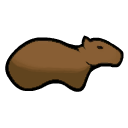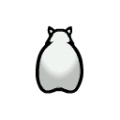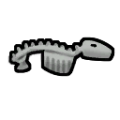Capybara
Capybara
The largest natural rodent, the capybara is well-adapted for steaming jungle environments.
Base Stats
- Type
- Animal
- Flammability
- 70%
Pawn Stats
- Move Speed
- 3.9 c/s
- Health Scale
- 70% HP
- Body Size
- 0.75
- Mass - Baby
- 9 kg
- Mass - Juvenile
- 22.5 kg
- Mass - Adult
- 45 kg
- Carrying Capacity
- 56 kg
- Filth Rate
- 8
- Hunger Rate
- 0.36 Nutrition/Day
- Diet
- herbivorous
- Life Expectancy
- 12 years
- Manhunter Chance
- 0%
- Manhunter Chance (Taming)
- 0%
- Trainable Intelligence
- None
- Wildness
- 75%
- Minimum Handling Skill
- 7
- Roam Interval
- 2 days
- Mate Interval
- 12 hours
- Maturity Age
- 0.333 years (20 days)
- Juvenile Age
- 0.2 years (12 days)
- Comfortable Temp Range
- -10 °C – 50 °C (14 °F – 122 °F)
Production
- Meat Yield
- 105
 capybara meat
capybara meat - Leather Yield
- 33
 lightleather
lightleather - Gestation Period
- 5.661 days
- Offspring Per Birth
- 1-2 (1.25 avg)
Melee Combat
- Attack 1
- Front left paw
8.4 dmg (Scratch)
13 % AP
2 second cooldown - Attack 2
- Front right paw
8.4 dmg (Scratch)
13 % AP
2 second cooldown - Attack 3
- Teeth
8.5 dmg (Bite)
13 % AP
2 second cooldown
0.7 chance factor - Attack 4
- Head
4 dmg (Blunt)
6 % AP
2 second cooldown
0.2 chance factor - Average DPS
- 2.27
- tradeTags
- AnimalUncommon
Capybaras are difficult to tame herbivores.
Obtaining
Capybaras can be found in tropical rainforests and tropical swamps only. They can either be tamed by a handler or self-tame in a random event.
Capybaras can be bought and sold in other faction bases and from exotic goods traders. Capybaras purchased from traders will be already tamed.
Summary
Capybaras are pen animals. Once tamed, pen animals cannot and do not need to be trained any further. But if left outside of a pen or caravan hitching spot, pen animals will eventually roam outside your colony. Making a caravan is not required to tie animals to a caravan hitching spot.
Analysis
Capybaras are one of many animals that exist to be hunted, or be manhunters, and not much else. They are otherwise outclassed by alpacas
Nutrition
When slaughtered, a capybara yields 26 meat and 15 leather as a baby; 53 meat and 21 as a juvenile; or 105 meat and 33 leather as an adult. 1 meat is equal to 0.05 nutrition.
An adult capybara consumes 0.36 nutrition per day, and creates up to 0.22 offspring per day.
- When offspring are slaughtered as babies, a female capybara will produce 0.29 nutrition of meat per day, giving a nutrition efficiency of 79.7%.
- If the offspring are allowed to grow to adulthood, they will consume an additional 0.86 nutrition per day, but will instead yield 1.16 nutrition per day as they are slaughtered, resulting in a nutrition efficiency of 95.1%.
When considering a population of equal numbers of males and females, these nutrition efficiencies fall to 39.9% for baby slaughter and 73.4% for adult slaughter.
Capybaras are strictly inferior for meat (per unit hunger) than both alpacas and chinchillas, both which can be found in tropical biomes. Alpacas can be sheared for wool and are pack animals, while chinchilla fur is a much more valuable trade good. Alpacas are easier to tame, and come in herds, meaning its easier to get a breeding pair of them.
Training
This animal can be trained as follows:
| Guard: | |
|---|---|
| Attack: | |
| Rescue: | |
| Haul: | |
*As of version 1.1.2610, all animals can be tamed. The percentage of likelihood of success depends on factors such as the Animals Wildness Percentage, Pawn Handling Skill, and others. More information can be found on the animals page.
Health
Gallery
Version history
- 0.12.906 - Added




